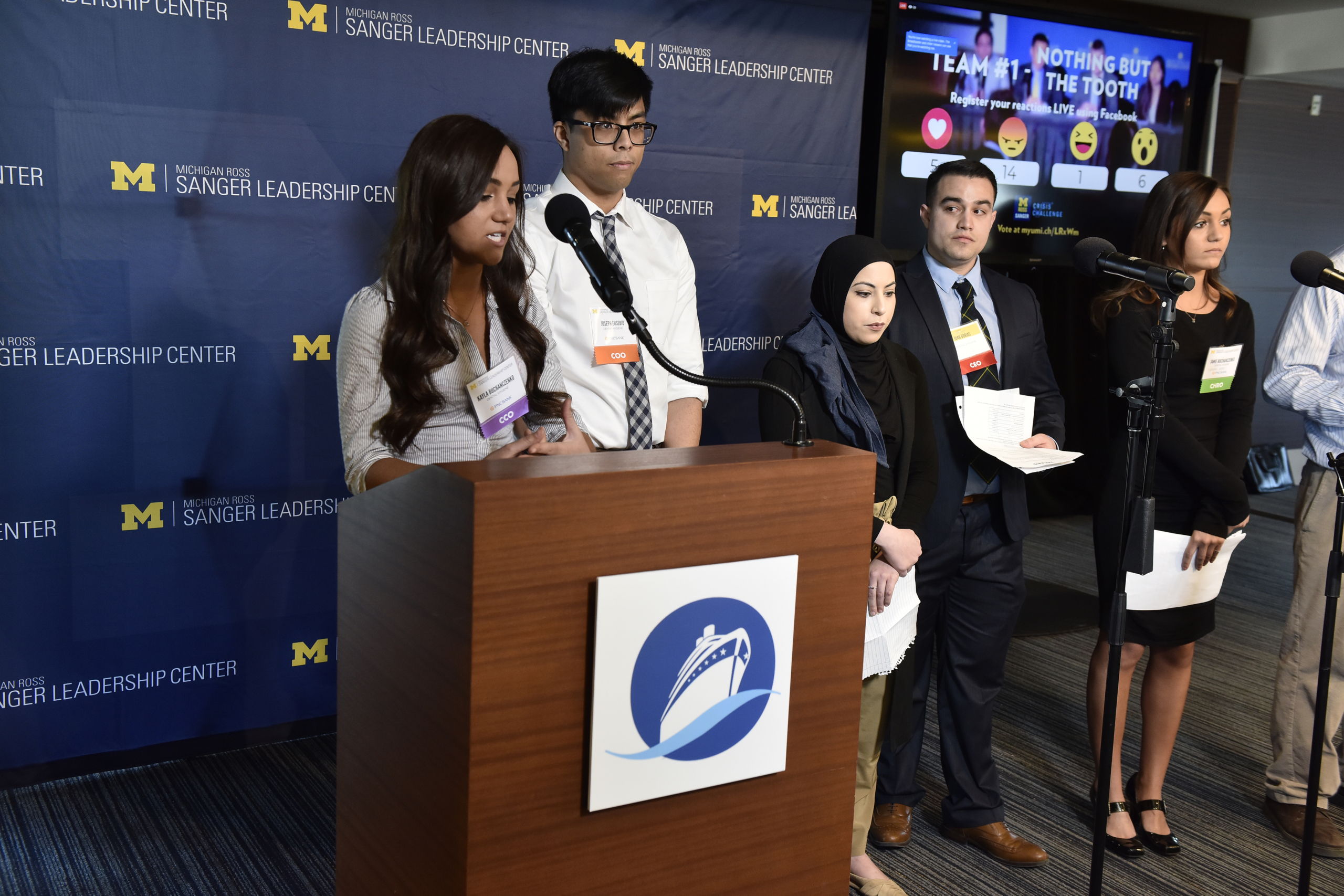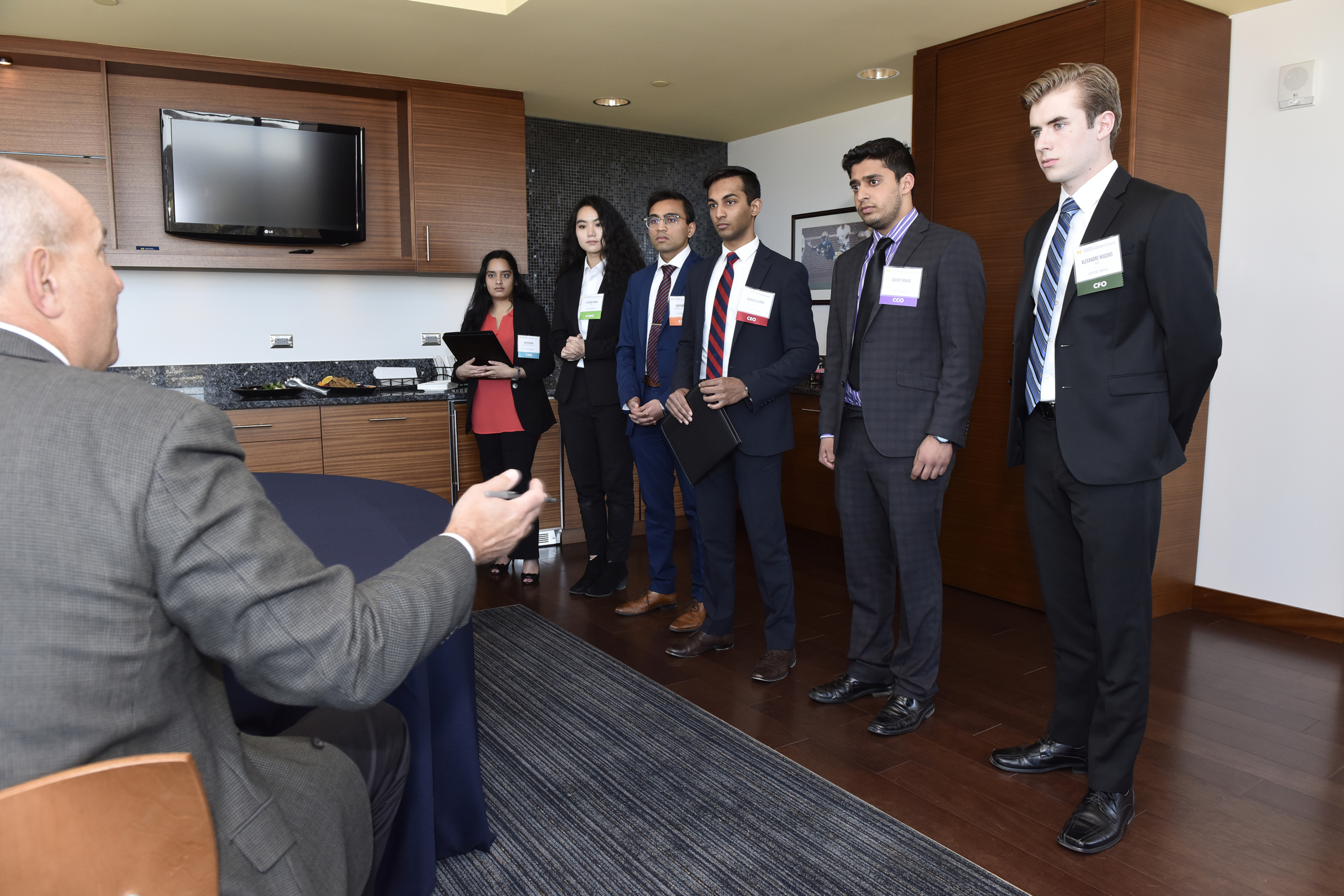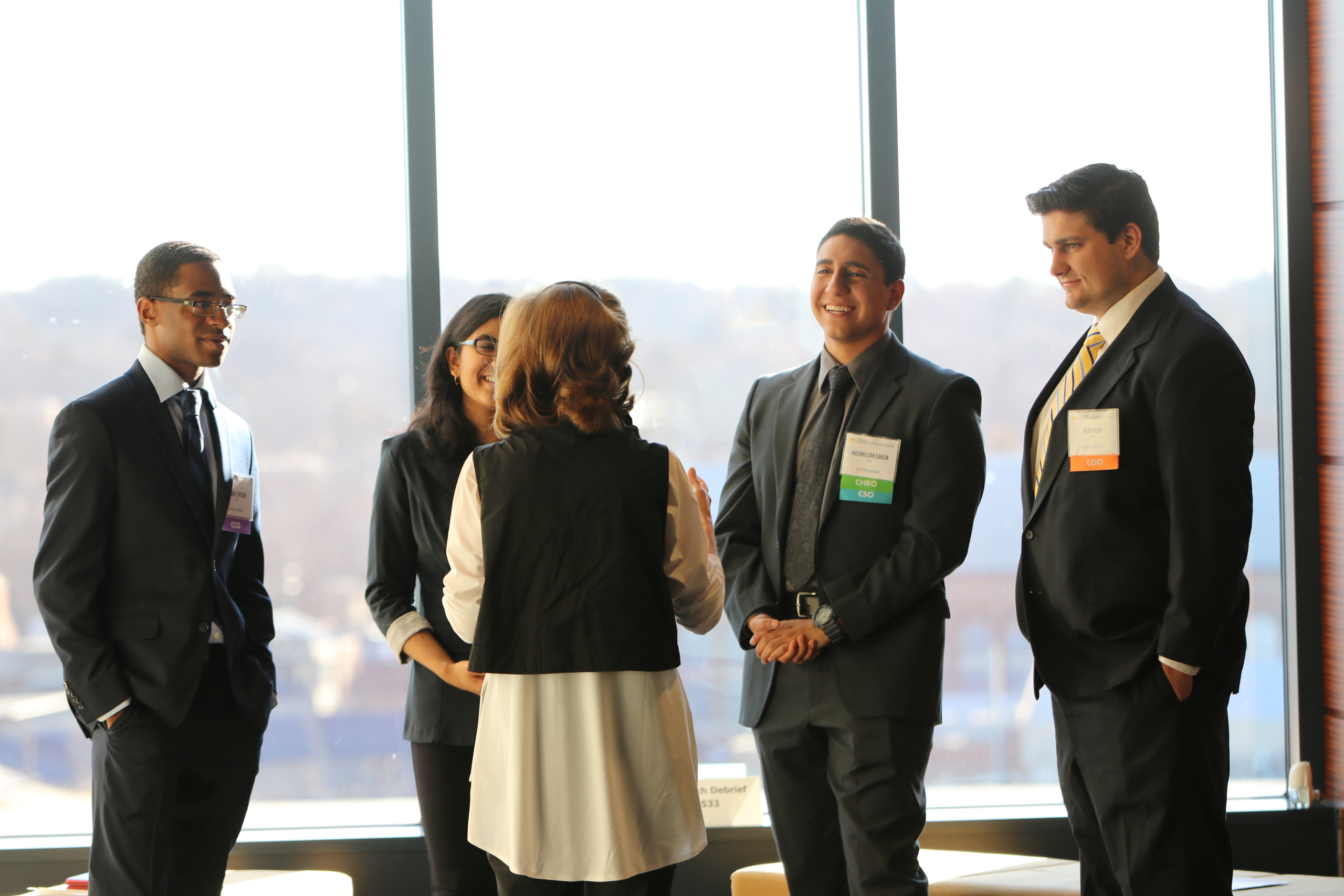
Sanger Leadership Center Crisis Challenge, Day #2, Jack Roth Stadium Club at Michigan Stadium, Friday, March 23, 2018.
Imagine you’re the CEO of a fictitious company. You’re tasked with navigating a public relations nightmare: you are the main suspect behind a catastrophic oil leak. It may be the reason why a school full of children have all been afflicted with food poisoning.
Those are the types of scenarios you face with the Leadership Crisis Challenge at the Ross School of Business. The challenge is an annual event offered to over 400 undergraduate and graduate students at U-M, typically beginning on a Thursday evening and lasting a total of 36 hours. During this time period, the challenge asks students to assume executive leadership roles to navigate a crisis that quickly spirals out of control.
HIGH STAKES, HIGH PRESSURE
The goal of the challenge is to compete with other teams to come up with the best public relations plan, handle competing pressures from different stakeholders, and (most importantly) find a unique solution to the problem. Even more, alumni from different industries will test your knowledge on the situation and offer new perspectives on handling different types of crises. Although the challenge may seem easy on the surface, it acts an ever-changing landscape that keeps you on your toes.
Whether dealing with an oil spill or an event as drastic as sick children, each crisis situation presents different challenges that must be handled with promptness and tact. To even start addressing the problem, you – as CEO – have to get past a rowdy crowd of protesters who have formed outside of the simulation’s doors. The cameras follow you as the media attempts to break through the crowd and get answers out of you – when you’re still trying to figure out what happened yourself. Overall, the simulation is meant to put you in a high stakes, high-pressure environment that teaches you what it’s like to lead a company under the intense scrutiny of the public.
I participated in the Crisis Challenge several times during my tenure at the University of Michigan. It requires strategic thinking as you are forced to confront late-breaking and ever-changing information as the situation evolves. At its inception, I thought that the challenge would be a standard simulation where you could just take a seat and write out your press media release. However, I soon found that there’s no hiding behind any curtains when you walk into the room.

Sanger Leadership Center Crisis Challenge, Day #2, Jack Roth Stadium Club at Michigan Stadium, Friday, March 23, 2018.
WEIGHING PAINFUL OPTIONS
You are immediately told to find a group you want to work with during the challenge. It’s a scramble to find team members whom you know you can trust before someone else takes your spot. Some groups form randomly; others are already pre-established. However, one thing is for sure: this two-day crisis situation will test and expose the integrity and diligence of every member of your team, whether you knew who you were working with or not.
After teams have been established and executive roles designated, it’s time to head into a small conference room where everyone has to contribute thoughts about how to address the problem. It’s nerve-wracking because you are constantly receiving new information and your email is blowing up with (fake) colleagues and lawyers threatening to sue you or offer words of disgust. As the crisis unfolds, you face complex decisions and a range of competing stakeholders. Success depends on your ability to effectively frame issues, rigorously analyze trade-offs, and articulate a clear, coherent strategy.
During the oil crisis, there were many items that required distinct decisions. First and foremost, would you even take responsibility for the crisis? If you denied responsibility, you could potentially avoid the whole situation. In contrast, if you took responsibility, you would immediately face negative media and poor brand recognition.
CHOOSE WISELY
This is one of the first decisions you are forced to make. If you choose incorrectly, you will automatically lose the challenge. Take the oil leak example. The wrong decision was a deal-breaker here because, later in the challenge, a report is released that shows your boat was the only one that was left undocked and near the accident. In other words, if you chose denial, your team has lost all credibility and should brace for a ferocious backlash. It is decisions like these that truly push you to think through every action, and every response that you give.
In my team, our strategy typically followed a Design Thinking Process. We focused on what would be best for the constituents who were affected. We wanted to get in front of the situation before it got out of hand. That way, we could control the narrative and continue pushing towards a solution.
No matter what, you will practice navigating an ambiguous environment that progressively becomes more arduous. The amount of pressure that is placed on you is exorbitant; you can’t slip up in any part of your strategy and your team has to be constantly responding in the right manner to be set for a win. This can mean sending a tweet that takes responsibility for the companies’ faults or issuing an apology for causing the crisis. It may even mean remaining silent.

Sanger Leadership Crisis Challenge team members meeting with Ross alumni judges
MEET THE ALUMNI
On this note, coming up with the perfect response, whether that is a response at all, is nearly impossible. It takes a skilled wordsmith to convey everything you need to say without deepening your exposure and damage. Even more, responding to shareholder concerns becomes nuanced because you are simultaneously trying to calm fears while taking action within your company. Once I dealt with all of this and the night concluded, I was mentally fatigued from all the items our team had to navigate through.
Still, we were far from finished.
Early the next morning, you have to report early to the Big House to meet with actual c-suite executives from companies like Blackrock, Goldman Sachs, Blackstone, and Bain & Company who volunteer to participate in the challenge. They act as the board of the company, who are there to both critique your decisions and offer advice. Whether you’re being attacked by them or given words of advice, it’s a tough crowd. They question every decision you made the previous evening and will threaten to fire everyone in your party. I know that the board offered some choice words for me.
When we asked for advice, they told us that they were not happy with how much we had spent in reparations for the harbor. It was right about this time that my blood began to run cold. I felt that we had made all of the wrong decisions and felt my heart beating faster and faster. It wasn’t until they got to the ancillary part of their statement that I felt relieved. Although they were not happy with our spending, they were happy with how we had come up with a new way to address the oil spill and purchased new technology which would prevent a future crisis
In the end, the board makes the final decision on whether you move on to the last part of the simulation or go home. If you do make it to the finalist round, you have the privilege (and misfortune) of being questioned by real representatives of the media.

Max Garcia at the Sanger Leadership Center Crisis Challenge, Day #2, Jack Roth Stadium Club at Michigan Stadium, Friday, March 23, 2018.
STAYING ON YOUR TOES
In my experience, the press conference is the hardest part of the simulation. Being one of the finalist teams, I was able to experience this part first-hand. Once the finalist teams arrive to the press conference, they are bombarded by what feels like 100 questions from multiple parties. It’s hard to answer everything and even harder to keep a straight head. You feel like you are in a whirlwind of angry reporters and people who are intentionally trying to trip you into saying something awful.
You have to be on your toes. For example, when a reporter asked, “How are you going to deal with the deaths of the local sea life?”, I didn’t freeze or place blame on anyone, instead, I thanked all of the medical staff who were brought in during the crisis to help the local habitat and stated that we were bolstering our efforts to handle the situation. During my first Crisis Challenge, I definitely was aghast by the amount of pressure that they do place on you during the simulation. Your heart beats a little faster when you’re on that podium because the press members have no mercy. Some finalist groups crack and become belligerent and sass the reporters. Other groups handle themselves with poise – but are still visibly shaken.
Once you are done with that final part, your group is judged and given a placement. This is the culmination of all of your hard work because winners receive recognition and a scholarship to split amongst the team. Whether you win or lose, you ultimately come away because of the experience. This is a once-in-a-lifetime opportunity to grow, meet, and network with actual executives (most are alumni).
My final time participating is coming up and I can’t wait for the challenge, One. Last. Time.
I’m Maximillian C. Garcia III, a young whippersnapper hailing from the small town of Rancho Cucamonga, California. I am majoring in Finance with a minor in Performance Arts Management at the University of Michigan’s Ross School of Business. My goal in life is to continuously explore my curiosity of the unknown. Finally, I fence the Sabre Blade on the Michigan Fencing Club to keep myself strategically growing and living up to learning about the unknown!











Questions about this article? Email us or leave a comment below.